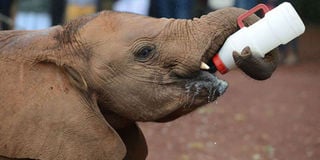Why we should not allow poachers to drive our elephants to extinction

A calf feeding at The David Sheldrick Wildlife Trust - Elephant Orphanage in Nairobi on August 12, 2014. Kenya has a key role to play in ensuring the survival of these magnificent animals. PHOTO | SIMON MAINA | AFP
What you need to know:
- Kenya continues to be the major transit point for illegal ivory shipped out of Africa to Asian markets.
- China bowed to international pressure and announced that it will phase out the legal trade in ivory by the end of 2017.
The World Elephant Day on August 12 is both a day for global celebration of elephants and a reminder that their conservation requires a global effort.
Kenya has a key role to play in ensuring the survival of these magnificent animals and the day is an opportunity to take stock.
How have our elephants fared over the past 12 months?
What are their prospects over the next year and beyond?
POACHING
The good news is that ivory poaching levels in Kenya remain low.
While official figures for 2016 are not yet available, deaths from poaching this year will be far fewer than the 300 to 400 elephants lost annually in the dark years of 2012-13.
We should applaud our law enforcement agencies for this.
IVORY
The bad news is that Kenya continues to be the major transit point for illegal ivory shipped out of Africa to Asian markets.
There was only one major seizure of ivory in Mombasa in 2016, but several other large consignments that passed through the port were seized on arrival by authorities in Southeast Asia.
We can only guess at the amount that flows through the port undetected, aided by lax security and, almost certainly, corruption among port officials.
DECREASE
Taking a long view, we should remember that there were more than 150,000 elephants in Kenya in the 1970s.
A catastrophic decline reduced the population to only 16,000 in the late 1990s.
The numbers have since increased to about 35,000, making Kenya one of the few countries in Africa where elephant populations are stable or increasing.
CHINA
While populations in southern Africa remain secure, elephant numbers in Tanzania and Mozambique are plunging and the situation of the few remaining animals in Central and West Africa remains precarious.
As long as there is demand for ivory, success in one country will only move the killing fields elsewhere.
At the end of 2016, China bowed to international pressure and announced that it will phase out the legal trade in ivory by the end of 2017.
EDUCATE
This was a major breakthrough. There are already signs that the Chinese ban is reducing prices on both the legal and illegal ivory markets across Southeast Asia.
But Chinese nationals are still frequently arrested trying to smuggle ivory products out of Kenya.
To achieve a significant, lasting reduction in demand, China needs to educate its citizens on the consequences of buying ivory.
HORROR
I regularly meet Chinese tourists to Kenya who believe that elephant tusks simply fall out on the plains, and then grow back, like deer antlers.
It’s my job then to take them through a painful reality check.
They are often left in tears when they understand the bloody horror that took place in order to produce the ivory trinkets they thought were so pretty.
DROUGHT
Even if poaching could be eliminated entirely, elephants in Kenya and across Africa face many other threats.
According to Kenya Wildlife Service statistics, elephant deaths this century peaked in 2009, when the principle cause of death was not poaching but ‘natural causes’.
Many of these deaths were undoubtedly caused, directly or indirectly, by the prolonged drought that affected Kenya that year.
CONFLICT
In 2017, the spectre of drought has returned to haunt us — and who knows what global warming has in store?
Drought brings humans and elephants — along with other wildlife — into competition for scarce water resources.
Maybe that is why, this year, human-elephant conflict has been constantly in the news.
Elephants not only damage crops and property, they sometimes kill people who get in their way.
ELECTIONS
The only lasting solution to human-elephant conflict is for humans to adopt sustainable patterns of development and resource use that leave elephants with the space to get on with their lives.
Wildlife conservation has hardly featured in the election campaigns.
If our leaders don’t talk about wildlife, it’s because they don’t think that we, the electorate, care about it.
CAMPAIGN
In this week leading up to World Elephant Day, let’s show the world that we care about elephants.
Join #DontLetThemDisappear movement online. Let’s make the ivory trade disappear, not our elephants.
Dr Kahumbu is a conservationist. [email protected]




